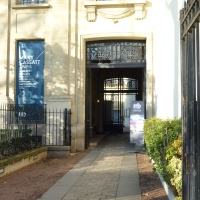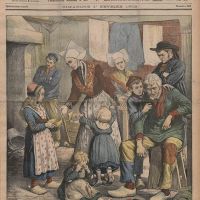Opinion is divided on whether the name “City of Light” refers to the brilliant minds of the city’s 18th-century philosophers, or to the brightly illuminated streets of the capital. There are arguments to be made on both sides.
If the latter is correct, there is no question that Paris works hard on its illuminations. As I photographed streetlights here and there, I couldn’t help wondering at the many different styles, and about the logistics of replacing bulbs and carrying out maintenance in a city with as many types of lamp standards as France has cheeses.
Even on a single street, one can see several versions. The Champs-Elysées has tall modern standards that do the main work of lighting the boulevard, and shorter, old-fashioned ones that provide atmosphere and elegance on the sidewalks.
This one near Les Invalides combines old-fashioned style with modern practicality on a single pole.
Each bridge seems to have its own version, from the elaborate lamps on the Pont Alexandre III…
… to the hideous modern ones on the Pont de l’Alma.
Some streets are too narrow to have lamp standards, so the lighting is attached to the walls of buildings.
It has taken more than three centuries to achieve this array of lighting in the city. Before the 16th century, Paris went dark when the sun set. Then the government formed a plan to require householders who had ground-floor windows overlooking main streets to keep a light burning, at least in the early hours of the evening. These lamps were to be provided by the authorities. But the cost of making and distributing them was too high. Paris stayed dark.
Someone suggested a system that would allow citizens to temporarily hire a torch from a network of torch-renters spaced at regular intervals – rather like a Velib’ system for light. There were no takers.
Public street lighting really began in the 17th century under the Sun King, Louis XIV. The lights were hung from ropes stretched across the streets. They consisted of a tallow candle in an iron-framed glass box. (Later, the candles were replaced with oil lamps.) There was even a plan to finance the system. Householders would pay a tax that covered both street cleaning and streetlighting (taxe des boues et des lanternes). This is one of the origins of today’s property tax – that necessary and unpopular civic obligation.
At first, the system required residents to participate by lowering the rope from an upper floor when the lamplighters approached, signalled by the ringing of a bell. Bad idea. Householders were seldom available or willing to act when they were needed. Eventually, mechanisms that lowered the line from the ground were installed, and protected in a locked box that was accessible only to lamplighters (a job outsourced to freelancers by committees in each district of the city).
Gabriel Nicholas de la Reynie, considered Paris’s first modern police chief, is credited with these first ventures into lighting infrastructure. Parisians may have mixed feelings about La Reynie: the street named for him is an insignificant two-block pedestrian way crossing the boulevard Sebastopol. La Reynie, one senses, may have stepped on some fairly significant toes in his quest for law, order, and good street lighting.
Reynie’s invention worked…most of the time. The lamps on ropes were easy targets for drunken miscreants, who liked to smash them as they passed. When the police responded by placing the ropes even higher up, ne’er-do-wells simply cut the ropes to enjoy watching a lamp plummet to the pavestones and smash to smithereens.
Lamps attached to buildings were slightly less vulnerable. But in the Revolution, these gallows-like contraptions were used for hangings. When you heard the expression, “A la lanterne!” it meant somebody’s number was up.
Revolutions and streetlights don’t mix. In subsequent upheavals (1830, 1848, and so on), lights were often smashed to allow rebels to move through the streets without being observed. Since the police were the originators of streetlighting (and lighting expenses were paid through the police budget), these lights were seen as symbols of official control. If the “City of Light” really does mean the City of Streetlights, not everyone wholeheartedly embraced this technology, or Paris’s light-filled reputation.
Gas light replaced the oil lamps in the 1840s. This was a bigger change than it sounds, because oil lamps are individual affairs, filled one at a time, but gas requires a centralized delivery system to each location. No doubt taxes went up.
Electricity arrived in the mid-19th century. The first electric street lights were bright, glaring arc lamps on very high poles that not only cast a harsh light, but also created very deep shadows. They were expensive, and used only in very well-frequented places, while the side streets kept the softer gaslights.
Today, Paris is subtly and carefully lit and each monument has its own customized lighting system to show it off to its best advantage … until a Bateau Mouche passes with its violent searchlights scraping the facades of the riverside buildings. The City of Light shines a bit too brightly then.
Text and photographs by Philippa Campsie
































Thanks again Philippa! Your words are always so nicely chosen, as are your photographic subjects!
What a fun subject for a post – hiding in plain sight!
A fascinating and very well-researched post. I think general opinion is that Paris is too well-lit today, so perhaps we will soon see a return to a darker age!
Pingback: The Sun King First Lit the City of Light « French News Online Newsroom
I enjoyed reading about the history of lighting in Paris. I would also be interested knowing something about the history of. Maybe a future post? the newspaper kiosks
Pingback: The Paris Blog: Paris, France Expat Tips & Resources »Blog Archive » City of Streetlights
Great article! Helpful to a Parisian expat looking for more info on the city’s lighting history. 🙂
bravo Philippa! KB
merci beaucoup, Philippa. Just what I needed. terry collins
According to paris-bise-art.blogspot.com there are a couple of oil lamp vestiges called
“Eclairage public a huile” at 10 rue des Grands Augustins and 14 rue des Trois Portes.
http://paris-bise-art.blogspot.com/2013/01/eclairage-public-huile.html
Thank you for providing the link. Amazing that such things survive to this day.
Philippa